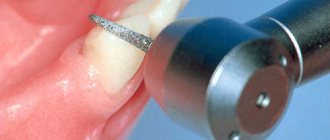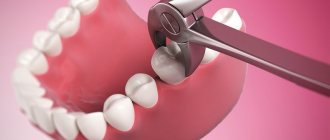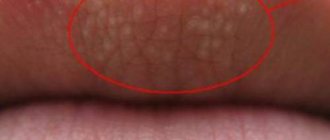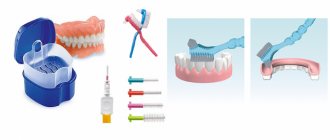A bridge on implants is a reasonable option for prosthetics in case of loss from 3 teeth to their complete absence. Cheaper than implantation of each lost tooth, more reliable than bridge prosthetics on your own teeth.
In our Center they are installed after computer diagnostics and bite examination, and are manufactured in our own dental laboratory. A lifetime warranty is provided for implants in our Center, and 25 years for metal-free crowns as part of a bridge.
A dental bridge on implants is a non-removable orthopedic structure made from welded crowns to restore several teeth in a row.
- Difference from traditional bridges The bridge is supported not by your own teeth, but by pre-installed implants. There is no need to grind down the enamel of adjacent healthy teeth.
- Difference from classical implantation Each tooth does not require a separate implant; fewer are installed. And the bridge includes crowns for each tooth. Allows you to save money.
Bridge prosthesis on implants
Advantages
If you lose several teeth in a row, dental bridges on implants are the right solution. Allows you to correctly distribute the load and not use healthy teeth.
- Neighboring teeth do not deteriorate. The supports are implants implanted into the jaw, and not your own teeth, which must be ground down.
- Durability Implants last a lifetime, and the service life of the prosthesis is at least twice as long as that of classic bridges.
- Aesthetics Crowns are no different from your own teeth. The aesthetic gingival contour is recreated.
- Affordability Savings compared to classic implantation, when each tooth is replaced with an implant and a crown.
Methods for fixing a bridge
Bridge prosthesis
We are talking about a non-removable orthopedic structure, in which several artificial crowns are combined with each other. Such a system can be fixed on ground live teeth, if they are preserved on both sides of the defect, on roots reinforced with pins/core inlays, or on implants.
The hard tissues of the supporting element are pre-ground. For metal-ceramic crowns, 2-2.5 mm are usually removed from the chewing surface and 1.5 mm on the sides. Each stump will be covered with hollow crowns located along the edges of the prosthesis.
As a rule, living supports are first depulped - the nerves are removed from them. This is necessary to avoid the risk of injury to the neurovascular bundle (pulp) during the preparation process. Sometimes, when using metal-ceramic prosthetics , molars are left alive, since the thickness of their hard tissues is much greater than that of incisors, canines and premolars. However, this decision remains at the discretion of the specialist.
A bridge can also be installed if the crowns located on the sides are almost destroyed. The main thing is that their roots remain intact. Such a tooth is additionally built up and strengthened with a pin or stump insert. If there are no roots left or they require removal, implants are implanted into the bone tissue to create artificial supports.
By the way, the latter method has several significant advantages. The fixation of the prosthesis is much stronger and more reliable. In addition, the installed implants will prevent further bone tissue atrophy, which occurs due to the long-term absence of chewing load within the defect.
Is it always possible to put a bridge on implants?
A bridge prosthesis on implants is suitable in any clinical situation, regardless of the extent and location of the defect in the jaw
Installed when:
- loss of three adjacent teeth in a row; with fewer teeth there is no need
- absence of outer teeth in a row , when there is no support on one side for a conventional bridge
- complete edentia , when there are absolutely no supports for fixation for a traditional bridge
Bridges on implants do not require grinding of adjacent teeth.
They are used even in cases of terminal defects and complete edentia, which cannot be achieved with traditional bridge prosthetics. Another undoubted advantage is that there is no need to prepare the enamel of neighboring teeth, which means they will remain healthy and last longer.
Levin Dmitry Valerievich Chief physician and founder of the Doctor Levin center
What to put on chewing teeth
In case of loss of molars, premolars, functionality comes first. The implant takes on the functions of a natural root and is able to withstand mechanical loads, correctly redistributing them to the jaw. In the case of a classic bridge, the load falls exclusively on the supporting dental units.
In the manufacture of orthopedic systems, the ROOTT clinic uses high-tech equipment and 3D computer modeling. This gives maximum accuracy of the prosthetic result. A crown or bridge that is tailored to your oral anatomy, bite, and occlusion is highly comfortable and will last much longer.
How many implants are needed for partially missing teeth?
When calculating the number of implants, we take into account the distribution of chewing load
The load on the jaw when chewing should be uniform so that there is no subsidence of the gums and bone tissue under the hinged crowns. This will ensure the durability of the prosthesis and maintain aesthetics. Therefore, fixing a bridge on 2 implants is not always the right solution. It is recommended to use a 1:2 calculation - one implant for 2 crowns . Accordingly, the more teeth are missing, the more implants will be needed.
1-2 teeth missing
In this situation, bridges supported by implants are not relevant; teeth are restored separately. Each one has its own implant, which is covered with a separate crown. In this case, it is not recommended to combine crowns - if one is damaged, you will have to remove two at once. No 3 teeth
The most common clinical picture.
If there are no three adjacent teeth in a row, 2 implants are implanted along the edges of the defect, and a prosthesis for 3 teeth in the form of interconnected crowns is fixed on them. The outer ones are mounted on supports, and the middle one is hinged. You can install three implants, but this solution is cheaper. 4 missing teeth
When installing a bridge on 4 missing teeth in a row, the number of supports increases to three, and the number of crowns increases to four.
If you use two supports, then there will also be two mounted crowns. Atrophy of the jaw bone under the prosthesis cannot be ruled out due to uneven load. And the risk of prosthesis breakage increases due to increased pressure on the central part. No 5 teeth
Bridge prosthetics on implants is possible for 5 teeth or more. If five teeth are missing, three implants are needed. If a bridge of 6 teeth or more is required, three supports are used - the number is calculated by the number of crowns in the structure. The degree of future load and its distribution on the bone tissue are taken into account to prevent atrophy.
What is important for patients to know before installing a dental bridge?
Cement allows you to smooth out the inaccuracies of the dental bridge by choosing a more suitable position in the oral cavity. Thanks to this, the prosthesis does not need to be adjusted, ground or re-processed, provided that the inaccuracy is minimal, most often caused by changes in the prepared teeth in the interval between taking impressions and installing the prosthesis. This period can reach 2 weeks. Even with the use of temporary restorations, the prepared teeth may have slight deviations. High-quality products have a maximum fit; in the presence of cavities and large gaps between the support and the prosthesis, it is impossible to achieve a hermetically sealed fixation, therefore it is important that the dental bridge is made accurately. In large spaces under the denture, microbes can accumulate, which lead to the development of caries and gum disease.
The disadvantages of cement fixation are also considered to be the toxicity of some types of adhesives. The cement remains under the crown and practically does not interact with the tissues of the mucous membrane. However, some substances can accumulate and over time cause irritation, itching or burning of the gums. This mainly applies to compositions that harden due to a chemical reaction. Chemical cements erode over time, leading to delamination of the structure. This occurs unevenly, causing patients to experience breakage, injury, or loss of the prosthesis with simultaneous breakage of the supporting tooth. Basically, bridge failure occurs if the patient ignores signs of loosening or if there is a lot of stress placed on the dental bridge. When using modern cementitious compounds, the risk of developing allergies or inflammation is minimal. However, a specialist must conduct a diagnosis to determine whether there is an allergy to the substances that make up the material.
If a dental bridge is installed on dental implants, then when using one-step or one-stage implantation techniques, the gums on the day of prosthetics have damage - incisions, which are then sued. It is almost impossible to control the flow of adhesive, so when fixing, the doctor relies on his experience and knowledge. The entry of cement into the gum incision causes inflammation, pain and subsequent development of complications. If there is a lack of experience, the amount of cement can be much larger, which is why it can get under the gum and cause inflammation. If insufficient cement is used, there will be too little adhesive inside the abutment crown to provide a tight seal and long-term fixation of the prosthesis. When chewing, this factor can lead to breakage and loss of the denture.
To check the reliability of the fastening, an x-ray examination is performed. X-rays are used to determine the areas under the dental bridge where there is cement and where it has eroded over time. If the cement content is insufficient, the prosthesis must be removed and reinstalled. The dental bridge is separated using ultrasound. It acts on the cement and destroys it, after which the structure separates. When using this method, the risk of damage to the supporting ground teeth or loosening of the supporting implants is higher than with screw fixation. In addition, it is more difficult to control the reliability of the attachment, so patients may experience prosthesis loss and damage to the internal structures of the oral cavity. If cracks or chips form on the supporting teeth when the prosthesis detaches, then the dental bridge cannot be used again. It will not fit tightly to teeth whose relief has changed. For safe subsequent prosthetics, the structure is re-made so that there are no cavities inside the crowns that accumulate plaque and microbes.
The choice of fixation method depends on the type of structure and clinical picture. The doctor himself chooses the fastening method, which will provide reliable fixation for a long time, prevent loosening and protect the dental bridge from damage.
Full bridges for the lower and upper jaw
In case of complete edentia, fixed bridge structures are reinforced with a metal arch
The arch unites the crowns, increases the strength of the bridge and allows it to withstand severe chewing loads. The number of implants is determined depending on the clinical picture, anatomical features and jaw size.
- In the upper jaw, bone tissue has a lower density, therefore, during implantation, a larger number of implants are used - 8 pieces.
- On the bottom , on the contrary, the bone is denser, so 6 implants are enough for complete prosthetics. This is subject to standard jaw sizes. If the patient has a large jaw, two more implants are added to evenly distribute the load and ensure safe operation of the prosthesis.
A dental bridge with 6 implants is usually solid, but a denture with 8 implants can be made segmented - from four sections. This is a more convenient option - if necessary, you can remove only one segment, and not the entire prosthesis.
Also, in case of complete absence of teeth, the All-on-4 and All-on-6 protocols are used. 4 or 6 implants are installed on one jaw in a certain way, observing the principles of load distribution. Immediately on the day of implantation, a temporary non-removable adaptive prosthesis is installed, and after 6 months it is replaced with a permanent one.
What materials are they made of?
Dentures are manufactured in the Center’s own dental laboratory, you can choose the appropriate option to suit your taste and budget
- Metal-ceramic The base of the crowns is a metal alloy, the top is covered with ceramic mass. Relatively inexpensive, yet durable and quite aesthetic. The main disadvantage of metal ceramics is the ability to oxidize and cause a bluish outline to appear on the gums over time. Service life - 15 years or more .
- Zirconium Can be all-zirconium or coated with ceramics. They can withstand any load, do not deform, and retain their original appearance. Identical to natural teeth, the shade is selected individually. More expensive than metal-ceramic ones, but last longer. Service life - 25 years or more.
We offer patients the most profitable and practical methods, so we reserve the advantage for metal-free structures. In our Center, dental bridges are created in our own digital production using Zirkonzahn Schule technology or at the PROCERA (Nobel Biocare) plant in Sweden.
How much does a metal-ceramic crown cost?
The cost of metal-ceramic crowns varies; it can cost two thousand, as much as six thousand, or even more. It all depends on what material was chosen for the crown. Naturally, a crown made of ordinary metal will be much cheaper than a crown made of gold or titanium. But at the same time, the last two materials are much more durable; such prostheses will last much longer.
How much does it cost to install metal ceramics?
If you're not a big fan of brushing your teeth, it's likely that you'll soon be a candidate for dental implants.
But you can lose a tooth even if you take good care of your teeth. What material is best for a prosthesis? Metal teeth do not look very aesthetically pleasing, but porcelain crowns are quite fragile. The best option is metal ceramics. When making metal-ceramic teeth, the metal crown is covered with a special layer similar to enamel.
The cost of installing an implant consists of the cost of materials, as well as the cost of work. How much does a metal-ceramic bridge cost?
Bridges are used when a tooth is partially destroyed. A bridge is a prosthesis for extracted teeth; it is practically suspended between two teeth.
The cost of this type of prosthetics is not as high as it might seem. Such a prosthesis will cost much less than replacing damaged teeth with implants.
If you decide to install metal ceramics, you can safely contact the MEDFAMILY network of dental clinics. Our branches are represented in the South-Western Administrative District, Southern Administrative District, and Northern Administrative District of Moscow.
Stages of installing a bridge on implants
The process includes several stages - diagnostic, surgical and orthopedic
Diagnostics and planning
Computer diagnostics are carried out, the data is necessary to assess the quality of bone tissue, and is used for virtual planning of the operation. In case of extended defects and complete absence of teeth, a bite examination is performed on an articulator so that after prosthetics the correct closure of the jaws is maintained. The treatment plan is drawn up by the orthopedist - he is the one who coordinates the work of the implantologist, determines the positioning points and the number of implants, taking into account future loads.
Implantation
During the operation, a calculated number of implants are implanted into the jaw. When bone tissue atrophies, osteoplasty is performed - bone tissue augmentation. This is necessary to create reliable fixation of the implants. We work only with premium Nobel Biocare systems and use original prosthetics . For anxious patients with cardiac problems, the possibility of surgery in medicated sleep is provided.
Temporary prosthetics
It will not be possible to install a permanent prosthesis immediately after implantation - you cannot create a strong load so as not to disturb the position of the implants. But you will never leave our Center without an orthopedic solution. On the same day, we will manufacture and install a temporary bridge from lightweight materials, which will hide the defect and last 2-4 or 6 months while the implants take root.
Permanent prosthetics
Permanent bridges are made after fittings and prototyping, taking into account the bite. Installed using transocclusal (screw) fixation. Unlike cement fixation, which is practiced in some clinics, the bridge, if necessary, can be removed without damaging the abutments (the connecting link between the implant and the prosthesis).
Indications for installation
Most often, such a metal-ceramic prosthesis is used to restore an entire fragment in a row, although it can also replace one missing tooth. The optimal length of a bridge fixed on living supports is 1-2 elements. It is recommended to place a structure 3-4 units long on implants. Otherwise, functional errors may occur, including overload and loosening of the supports.
When making dentures, dental technicians use impressions taken from the jaws in advance. Until the product is ready, the patient is offered a temporary structure to hide the aesthetic defect. The bridge is fixed on living supports using dental cement, on implants in the same way or by screw fixation. In any case, you will not be able to remove the prosthesis yourself; only a doctor can do this in a dental office.
Bridge on implants or your own teeth - comparison
Each type of prosthetics has its own indications, advantages and disadvantages.
| Tooth-supported bridges | Implant-supported bridges |
| Prosthetic options Up to 3-4 teeth, not suitable for end defects | Prosthetic options From 3 teeth in a row to complete absence |
| Grinding of adjacent teeth is required | Grinding of adjacent teeth Not required |
| Reliability of fastening Possible tooth mobility due to periodontal diseases and inflammation | Reliability of fastening Complete stability due to the fusion of implants with the jaw bone tissue |
| Probability of bone atrophy High - the bone in the area of the defect dissolves and decreases without load | Probability of bone atrophy Low - the load on the bone is uniform due to the installation of the required number of implants |
| Service life Up to 7 years, depending on the condition of the supporting teeth | Service life of a prosthesis - from 15 years, implants - a lifetime |
| Price Lower - costs only for prosthetics | Price Higher - the cost of implantation is added |
In all respects, bridges on implants are superior , the only drawback is the cost in financial and time terms. First, implantation is performed, which requires additional costs and time.
A permanent bridge can be installed only after the implants have healed in order to avoid their displacement during chewing. But this does not mean that you will be left without teeth during this period. Immediately after the operation, we will make a temporary prosthesis that will last until the permanent one is installed and will hide the work performed. You will never leave our Center without teeth!
Advantages of crowns and dentures made of metal-free ceramics
Dental crowns made of metal-free ceramics are made in strict accordance with the natural color and shape of the patient’s teeth.
The products are not equipped with a metal frame; its role is played by a base made of especially durable ceramics. This technology is ideal for the restoration of front teeth, since the crown is indistinguishable from a living tooth. In addition to crowns, dentures can also be made from it. Porcelain does not come into contact with the environment, therefore it is absolutely harmless to the body. Therefore, it has become a real discovery in modern dentistry and is called the most advantageous and safe technology.
In terms of its aesthetic properties, it is very similar to living teeth. It is characterized by the same degree of light refraction as natural tooth enamel. Moreover, even a highly qualified dentist will not be able to visually distinguish between a crown made using the latest technology and a real tooth. When making crowns, the individual characteristics of the patient’s “native” teeth are always taken into account. It turns out that the cosmetic effect of this modern material is one hundred percent.
However, do not forget that practicality is as important as beauty. Not so long ago there was an opinion that ceramics are only for the front teeth, that is, really only for beauty. In fact, at first, ceramic crowns were not designed to withstand any loads. But the latest casting technology has solved this problem. Crowns obtained using this method are much higher quality and stronger than their predecessors, and therefore are popular with both patients and dentists. Of course, before starting dental reconstruction using the latest methods and materials, the patient should get an idea about metal-free ceramics, prices, reviews, and also consult with his dentist. By the way, you don’t have to worry about the fact that you will have to experience certain inconveniences from the moment you order permanent structures until the moment they are installed. There are temporary crowns that hide the defect and allow the patient not to experience
Now about the cost: it directly depends on what material is used for the crown.
Service life of bridges on implants
Implant-supported bridges have increased stability compared to bridges supported on your own teeth. The period of operation does not depend on the condition of the supporting teeth, which over time can become loose from increased loads.
Implants create a uniform load on the bone tissue, eliminating subsidence of the bone under the prosthesis, thereby extending the service life of the structure. Metal-ceramic dentures last from 10 years, zirconium – from 25 years.
a 25-year guarantee on metal-free crowns supported by implants . The Center's warranty on the implants themselves . We use only premium Nobel Biocare implant systems and original prosthetics.
Which is cheaper: an implant or a bridge?
The cost of methods to combat edentia depends on:
- regional location of the clinic;
- level of qualification of specialists;
- quality of materials and equipment.
Naturally, regional centers provide services cheaper than capital ones. In Moscow clinics, one implant can be installed for 20-90 thousand rubles; in a district hospital, doing the same procedure will be cheaper. The situation is the same with prosthetics. In the capital, you can install a bridge for 10 thousand rubles, in the regions - for 7 thousand.
Here is a comparative table of prices for two methods of dental restoration, based on the materials used:
| Type of service | Cost, rub. |
| Implants (1 unit without crown) | |
| Osstem | from 20000 |
| Alpha Bio | from 21000 |
| M.I.S. | from 23000 |
| Implantium | from 26000 |
| Nobel Biocare | from 45000 |
| Astra Tech | from 45000 |
| Bridge prosthesis (1 unit) | |
| Metal ceramics | 7000-19000 |
| Ceramics | 15000-43000 |
| Zirconium dioxide | 20000-45000 |
What does the cost consist of?
Our Center provides a case payment system
The implant installation case includes:
- local anesthesia;
- cost of the Nobel Biocare implant and its installation;
- consumables and superstructures;
- applying and removing sutures;
- control CT diagnostics after surgery.
The case for installing a bridge includes:
- taking impressions;
- production of prosthesis;
- fitting and fixation of the structure.
Paid separately:
- Diagnostic case before implantation - the cost depends on the necessary studies.
- Osteoplastic surgery if necessary - the price is calculated depending on the type of bone augmentation and the duration of the defect.
- Sedation - calculated for each hour spent in medicated sleep. Usually 1 hour is enough to install 2-3 implants.
The total cost of bridge prosthetics on implants is formed taking into account:
- length of the defect;
- type and number of implants;
- number of crowns in the structure;
- the need for osteoplasty;
- use of sedation.
Nuances of care
Caring for a bridge
There are different options for connecting the intermediate part of the prosthesis and the mucosa, but most often it is the flushing type. There is free space under the body of the structure, which greatly simplifies hygienic care and also prevents the accumulation of plaque and deposits.
For high-quality cleaning of the rinsing space and hard-to-reach places, it is recommended to use a special dental brush and irrigator. Otherwise, oral care remains the same - you should brush your teeth at least twice a day and do not forget to rinse your mouth after each meal. Every six months, you must visit the dentist for preventive examinations and, with the same frequency, undergo professional cleaning to remove plaque and deposits.
In our dentistry in Moscow you can undergo prosthetics using modern technologies and materials. Our team consists of experienced, highly qualified specialists who find an individual approach to solving each clinical problem. You can find out the prices for the clinic’s services by looking at our price list.
Still have questions? We will be happy to answer them - call and sign up for a free consultation!
Date of publication: September 20, 2020 Last update: September 22, 2022 © 2020 Professorial Dentistry “22 Century”. All rights reserved.









